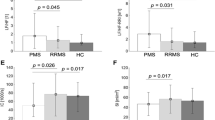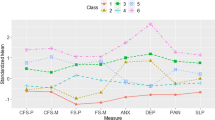Abstract
Introduction
Multiple sclerosis (MS) is an immune-mediated, neurodegenerative disease of the central nervous system. Fatigue represents one of the most prevalent and limiting symptoms of MS, and is associated with vascular dysfunction, notably increased arterial stiffness.
Objective
This study examined the relationship between arterial stiffness and perceived fatigue in persons with MS.
Methods
The sample of 52 persons with MS (71.2% Female; Age: 46.7 ± 12.3 yrs.) completed arterial stiffness and fatigue assessments as baseline for an exercise training intervention. Applanation tonometry measured arterial stiffness, pulsatility and waveform characteristics, and yielded the following outcomes: carotid-femoral pulse wave velocity (cfPWV), carotid pulse-pressure (cPP), and aortic augmentation pressure (AP). Perceived fatigue was measured using the Fatigue Severity Scale (FSS).
Results
The mean (SD) scores for cfPWV, cPP, and AP were 7.0 ± 1.8 m/s, 35.7 ± 8.8 mmHg, 8.2 ± 6.2 mmHg, respectively. The mean (SD) FSS score was 4.6 ± 1.4 and indicated elevated fatigue. There were statistically significant (p < .05) inverse correlations between cfPWV (r = –.32), cPP (r = –.37) and AP (r = –.32) with FSS scores, and the correlations remained significant even after controlling for disability, body mass index, age, and sex.
Conclusion
Our results indicate a consistent pattern of inverse relationships between arterial stiffness, pulsatility, and waveforms with fatigue independent of disability, body mass index, age, and sex in MS. This could be explained by lower sympathetic activation linking higher arterial stiffness, pulsatility and augmentation pressure with lower fatigue in persons with MS.

Similar content being viewed by others
Data Availability
Data available on request from the authors.
References
Wallin MT et al (2019) The prevalence of MS in the United States: a population-based estimate using health claims data. Neurology 92(10):e1029–e1040. https://doi.org/10.1212/WNL.0000000000007035
Lassmann H (2018) Multiple sclerosis pathology. Cold Spring Harb Perspect Med 8(3):a028936. https://doi.org/10.1101/cshperspect.a028936
Braley TJ, Chervin RD (2010) Fatigue in multiple sclerosis: mechanisms, evaluation, and treatment. Sleep 33(8):1061–1067. https://doi.org/10.1093/sleep/33.8.1061
Gumus H (2018) Fatigue can be objectively measured in multiple sclerosis: multipl sklerozda yorgunluk objektif olarak olculebilir. Noro Psikiyatr Ars 55(Suppl 1):S76–S79. https://doi.org/10.29399/npa.23396
Zimek D, Miklusova M, Mares J (2023) Overview of the current pathophysiology of fatigue in multiple sclerosis, its diagnosis and treatment options - review article. Neuropsychiatr Dis Treat 19:2485–2497. https://doi.org/10.2147/NDT.S429862
Manjaly ZM et al (2019) Pathophysiological and cognitive mechanisms of fatigue in multiple sclerosis. J Neurol Neurosurg Psychiatry 90(6):642–651. https://doi.org/10.1136/jnnp-2018-320050
Mitchell GF (1985) Aortic stiffness, pressure and flow pulsatility, and target organ damage. J Appl Physiol 125(6):1871–1880. https://doi.org/10.1152/japplphysiol.00108.2018
Yarraguntla K, Bao F, Lichtman-Mikol S, Razmjou S, Santiago-Martinez C, Seraji-Bozorgzad N, Sriwastava S, Bernitsas E (2019) Characterizing fatigue-related white matter changes in MS: a proton magnetic resonance spectroscopy study. Brain Sci 9(5):122. https://doi.org/10.3390/brainsci9050122
Marrie RA et al (2010) Vascular comorbidity is associated with more rapid disability progression in multiple sclerosis. Neurology 74(13):1041–1047. https://doi.org/10.1212/WNL.0b013e3181d6b125
Ranadive SM et al (2012) Vascular dysfunction and physical activity in multiple sclerosis. Med Sci Sports Exerc 44(2):238–243. https://doi.org/10.1249/MSS.0b013e31822d7997
Zheng P, Pilutti LA, DuBose NG, Motl RW (2023) Vascular function and cognition in persons with multiple sclerosis: preliminary examination. Mult Scler Relat Disord 71:104578. https://doi.org/10.1016/j.msard.2023.104578
Chirinos JA et al (2005) Aortic pressure augmentation predicts adverse cardiovascular events in patients with established coronary artery disease. Hypertension 45(5):980–985. https://doi.org/10.1161/01.HYP.0000165025.16381.44
Heffernan KS et al (2011) Pulse pressure is associated with walking impairment in multiple sclerosis. J Neurol Sci 309(1–2):105–109. https://doi.org/10.1016/j.jns.2011.07.004
Marrie RA et al (2022) Effects of vascular comorbidity on cognition in multiple sclerosis are partially mediated by changes in brain structure. Front Neurol 13:910014. https://doi.org/10.3389/fneur.2022.910014
Griffith G, Klaren RE, Motl RW, Baynard T, Fernhall B (2015) Experimental protocol of a randomized controlled clinical trial investigating exercise, subclinical atherosclerosis, and walking mobility in persons with multiple sclerosis. Contemp Clin Trials 41:280–286. https://doi.org/10.1016/j.cct.2015.02.003
Baynard T, Griffith GJ, Wee SO, McMillan NJ, Bollaert RE, Motl RW, Fernhall B (2023) Home-based exercise improves subclinical atherosclerosis marker in multiple sclerosis. Mult Scler Relat Disord 79:105002. https://doi.org/10.1016/j.msard.2023.105002
Kurtzke JF (1983) Rating neurologic impairment in multiple sclerosis: an expanded disability status scale (EDSS). Neurology 33(11):1444–1452. https://doi.org/10.1212/wnl.33.11.1444
Krupp LB, LaRocca NG, Muir-Nash J, Steinberg AD (1989) The fatigue severity scale. Application to patients with multiple sclerosis and systemic lupus erythematosus. Arch Neurol 46(10):1121–1123. https://doi.org/10.1001/archneur.1989.00520460115022
Boberg E, Iacobaeus E, Greenfield MS, Wang Y, Msghina M, Le Blanc K (2022) Reduced prefrontal cortex and sympathetic nervous system activity correlate with fatigue after aHSCT. Bone Marrow Transplant 57(3):360–369. https://doi.org/10.1038/s41409-021-01539-9
Keller DM, Fadel PJ, Harnsberger MA, Remington GM, Frohman EM, Davis SL (2014) Reduced spontaneous sympathetic nerve activity in multiple sclerosis patients. J Neurol Sci 344(1–2):210–214. https://doi.org/10.1016/j.jns.2014.06.053
Sirbu CA et al (2020) Autonomic dysfunctions in multiple sclerosis: challenges of clinical practice (Review). Exp Ther Med 20(6):196. https://doi.org/10.3892/etm.2020.9326
Mincu RI et al. (2018) Impaired cardiac function in patients with multiple sclerosis by comparison with normal subjects. Sci Rep 8(1):3300. https://doi.org/10.1038/s41598-018-21599-0
Flachenecker P, Reiners K, Krauser M, Wolf A, Toyka KV (2001) Autonomic dysfunction in multiple sclerosis is related to disease activity and progression of disability. Mult Scler 7(5):327–334. https://doi.org/10.1177/135245850100700509
Sheng Y, Zhu L (2018) The crosstalk between autonomic nervous system and blood vessels. Int J Physiol Pathophysiol Pharmacol 10(1):17–28. [Online]. Available: https://www.ncbi.nlm.nih.gov/pubmed/29593847
Tanaka M et al (2015) Frontier studies on fatigue, autonomic nerve dysfunction, and sleep-rhythm disorder. J Physiol Sci 65(6):483–498. https://doi.org/10.1007/s12576-015-0399-y
Funding
Research reported was funded by the National Multiple Sclerosis Society RG 4702A1/2.
Author information
Authors and Affiliations
Contributions
S.D. analyzed data, interpreted results, drafted, and revised manuscript and prepared tables and figure. N.D. contributed to drafting the manuscript, and prepared tables. T.B., and R.M. edited the manuscript. B.F., designed research, and edited the manuscript. All authors approved the final version of the manuscript.
Corresponding author
Ethics declarations
Conflicts of interest
The authors declare no conflicts of interest.
Ethical approval and Informed consent
All procedures received ehtical approval by the Institutional Review Board at the University of Illinois at Chicago, and written informed consent was provided by all participants.
Additional information
Publisher's Note
Springer Nature remains neutral with regard to jurisdictional claims in published maps and institutional affiliations.
Rights and permissions
Springer Nature or its licensor (e.g. a society or other partner) holds exclusive rights to this article under a publishing agreement with the author(s) or other rightsholder(s); author self-archiving of the accepted manuscript version of this article is solely governed by the terms of such publishing agreement and applicable law.
About this article
Cite this article
DeJonge, S.R., DuBose, N.G., Motl, R.W. et al. Inverse association between arterial stiffness and perceived fatigue independent of disability status and BMI in multiple sclerosis. Neurol Sci (2024). https://doi.org/10.1007/s10072-024-07556-y
Received:
Accepted:
Published:
DOI: https://doi.org/10.1007/s10072-024-07556-y




